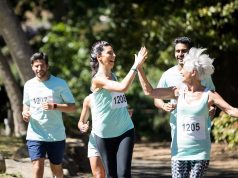Reductions in central blood pressure, aortic stiffness seen in first-time marathon completers
TUESDAY, Jan. 7, 2020 (HealthDay News) — Training for and completing a first marathon is associated with reduced central blood pressure and aortic stiffness, according to a study published in the Jan. 7 issue of the Journal of the American College of Cardiology.
Anish N. Bhuva, M.B.B.S., from University College London, and colleagues assessed 138 untrained healthy individuals before marathon training and two weeks after the marathon for central (aortic) blood pressure and aortic stiffness using cardiovascular magnetic resonance distensibility. The chronological age-stiffness relationship was used to calculate biological aortic age. At the ascending (Ao-A) and descending aorta at the pulmonary artery bifurcation (Ao-P) and diaphragm (Ao-D), the change in stiffness was assessed.
The researchers found that a decade of chronological aging at baseline correlated with decreases of 2.3, 1.9, and 3.1 × 10−3 mm Hg−1 in Ao-A, Ao-P, and Ao-D distensibility, respectively. Systolic and diastolic central (aortic) blood pressure decreased by 4 and 3 mm Hg, respectively, with training. There was an increase in descending aortic distensibility (Ao-P, 9 percent; Ao-D, 16 percent), but there was no change in Ao-A. These numbers represented a decrease in aortic age of 3.9 and 4.0 years, respectively, for Ao-P and Ao-D. Greater benefit was observed in older male participants with slower running times.
“Our study highlights the importance of lifestyle modifications to slow the risks associated with aging, especially as it appears to never be too late as evidenced by our older, slower runners,” a coauthor said in a statement.
Copyright © 2020 HealthDay. All rights reserved.








